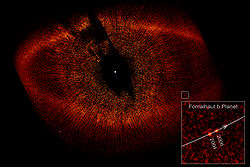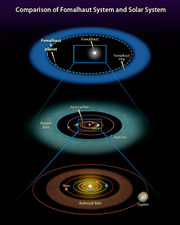Fomalhaut
 Debris ring around Fomalhaut showing location of planet Fomalhaut b—imaged by Hubble Space Telescope's coronagraph. NASA photo. |
|
| Observation data Epoch J2000 Equinox J2000 |
|
|---|---|
| Constellation | Piscis Austrinus |
| Pronunciation | /ˈfoʊməlhɔːt/ |
| Right ascension | 22h 57m 39.0465s |
| Declination | −29° 37′ 20.050″ |
| Apparent magnitude (V) | 1.16 |
| Characteristics | |
| Spectral type | A3 V |
| U−B color index | 0.08 |
| B−V color index | 0.09 |
| Astrometry | |
| Radial velocity (Rv) | +6.5 km/s |
| Proper motion (μ) | RA: +329.22 mas/yr Dec.: −164.22 mas/yr |
| Parallax (π) | 130.58 ± 0.65 mas |
| Distance | 25 ± 0.1 ly (7.66 ± 0.04 pc) |
| Absolute magnitude (MV) | 1.73 |
| Details | |
| Mass | 2.1 ± 0.2[1] M☉ |
| Radius | 1.832[1] R☉ |
| Surface gravity (log g) | 4.21[1] |
| Luminosity | 17.66[1] L☉ |
| Temperature | 8,751[1] K |
| Metallicity | [Fe/H] = −0.03[2] to −0.34[3] |
| Rotational velocity (v sin i) | 93[1] km/s |
| Age | (2 ± 1) × 108[1] years |
| Other designations | |
| Database references | |
| SIMBAD | data |
| NStED | data |
| ARICNS | data |
| Extrasolar Planets Encyclopaedia |
data |
Fomalhaut (α PsA / α Piscis Austrini / Alpha Piscis Austrini) is the brightest star in the constellation Piscis Austrinus and one of the brightest stars in the sky. Fomalhaut can be seen low in the southern sky in the northern hemisphere in fall and early winter evenings. Near latitude 50˚N, it sets around the time Sirius rises, and does not reappear until Antares sets. Its name means "mouth of the whale", from the Arabic فم الحوت fum al-ḥawt. It is a class A star on the main sequence approximately 25 light-years (7.7 pc) from Earth. It is classified as a Vega-like star that emits excess infrared radiation, indicating it is surrounded by a circumstellar disk.
Fomalhaut holds a special significance in extrasolar planet research, as it is the center of the first stellar system with an extrasolar planet (Fomalhaut b) imaged at visible wavelengths. The image was published in Science in November 2008.[4]
Contents |
Properties
Fomalhaut is believed to be a young star, only 100 to 300 million years old, with a potential lifespan of a billion years.[5][6] The surface temperature of the star is around 8,751 K (15,292 °F; 8,478 °C). Fomalhaut's mass is about 2.1 times that of the Sun, its luminosity is about 18 times greater, and its diameter is roughly 1.8 times as large.
Fomalhaut is metal-deficient as compared to the Sun, which means a smaller percentage of Fomalhaut is composed of elements other than hydrogen and helium.[1] The metallicity is typically determined by measuring the abundance of iron in the photosphere relative to the abundance of hydrogen. A 1997 spectroscopic study measured a value equal to 93% of the Sun's abundance of iron.[2][nb 1] A second 1997 study deduced a value of 78% by assuming Fomalhaut has the same metallicity as the neighboring star TW Piscis Austrini.[7] In 2004, a stellar evolutionary model of Fomalhaut yielded a metallicity of 79%.[1] Finally, in 2008, a spectroscopic measurement gave a significantly lower value of 46%.[3]
Fomalhaut is a member of the 16 stars belonging to the Castor Moving Group. This is an association of stars that share a common motion through space and are therefore likely to be physically associated. Other members of this group include Castor and Vega. This moving group has an estimated age of 200 ± 100 million years and originated from the same location.[5] The nearby star TW Piscis Austrini, a member of this group, may form a physical pair with Fomalhaut.[7]
System

Fomalhaut is surrounded by a debris disk of dust in a toroidal shape with a very sharp inner edge at a radial distance of 133 AU (1.99×1010 km; 1.24×1010 mi), inclined 24 degrees from edge-on.[8][9] The dust is distributed in a belt about 25 AU wide. The geometric center of the disk is offset by about 15 AU (2.2×109 km; 1.4×109 mi) from Fomalhaut.[10] The disk is sometimes referred to as "Fomalhaut's Kuiper belt". Fomalhaut's dusty disk is believed to be protoplanetary,[11] and emits considerable infrared radiation. Measurements of Fomalhaut's rotation indicate that the disk is located in the star's equatorial plane, as expected from theories of star and planet formation.[12]
On November 13, 2008, astronomers announced the discovery of an extrasolar planet orbiting just inside the debris ring. This was the first extrasolar planet to be seen with visible light, captured by the Hubble Space Telescope.[13][14] The planet's existence had been previously suspected from the sharp, elliptical inner edge of Fomalhaut's debris disk.[15] The mass of the planet, Fomalhaut b, is estimated to be no more than three times the mass of Jupiter and at least the mass of Neptune. There are indications that the planet's orbit is not apsidally aligned with the dust disk, which may indicate that additional planets may be responsible for the dust disk's structure.[16] However M-band images taken from the MMT Observatory put strong limits on the existence of gas giants within 40 AU of the star.[17]
| Companion (in order from star) |
Mass | Semimajor axis (AU) |
Orbital period (years) |
Eccentricity |
|---|---|---|---|---|
| b | 0.054 - 3.0 MJ | ~115 | ~872 | ~0.11 |
| Dust disk | 133 — 158 AU | |||
Visibility
At a declination of -29.6°, Fomalhaut is located south of the celestial equator, and hence is best viewed from the Southern Hemisphere. It passes virtually overhead from places just south of the Tropic of Capricorn, for example Brisbane, Johannesburg and Easter Island. However, its southerly declination is not as great as that of stars such as Acrux, Alpha Centauri and Canopus, meaning that, unlike them, Fomalhaut is visible from a large part of the Northern Hemisphere as well. South of latitude 40˚ north it can be viewed on autumn evenings; further north it is low on the southern horizon. It reaches a maximum altitude of only 9˚ from London, 4˚ from Edinburgh or Copenhagen, and it just barely rises from around latitude 60˚ north; Oslo, Helsinki or southern Alaska. Fomalhaut can be located in these northern latitudes by the fact that the western (right-hand) side of the Square of Pegasus points to it. Continue the line from Beta to Alpha Pegasi towards the southern horizon; Fomalhaut is about 45˚ south of Alpha Pegasi, with no bright stars in between.
Etymology and cultural significance
Fomalhaut has had various names ascribed to it through time. One such name in common use is the Lonely Star of Autumn, because it is the only first-magnitude star in the autumn sky of mid-northern latitudes. It has been recognized by many cultures of the northern hemisphere, including the Arabs, Persians and Chinese. Archaeological evidence links it to rituals dating back to about 2500 BC. It is one of the Persians' four "royal stars".
- The name Fom al-Haut comes from scientific Arabic فم الحوت fam al-ħūt (al-janūbī) "the mouth of the (southern) fish/whale"
- The Latin names are ōs piscis merīdiāni, ōs piscis merīdionālis, ōs piscis notii "the mouth of the southern fish"
- The name Difda al Auwel comes from the colloquial Arabic الضفدع الأول aḍ-ḍifdiˤ al-’awwal "the first frog" (the second frog is Beta Ceti)
To the Moporr Aboriginal people of South Australia, it is a masculine being called "Buunjill".[18]
In Walter Tevis' novel Steps of the Sun, Fomalhaut is visited by the protagonist and two potentially inhabitable planets are found (and described).
See also
- HR 8799
- GJ 758
- 2M1207
- List of extrasolar planets
- Direct imaging of extrasolar planets
- Fomalhaut in fiction
Notes
- ↑ If m = [Fe/H], then the ratio of iron to hydrogen for Fomalhaut divided by the ratio of iron to hydrogen for the Sun is given by 10m.
References
- ↑ 1.0 1.1 1.2 1.3 1.4 1.5 1.6 1.7 1.8 Di Folco, E.; Thévenin, F.; Kervella, P.; Domiciano de Souza, A.; Coudé du Foresto, V.; Ségransan, D.; Morel, P. (November 2004). "VLTI near-IR interferometric observations of Vega-like stars. Radius and age of α PsA, β Leo, β Pic, ɛ Eri and τ Cet". Astronomy and Astrophysics 426: 601–617. doi:10.1051/0004-6361:20047189. Bibcode: 2004A&A...426..601D. This paper lists [Fe/H] = -0.10 dex.
- ↑ 2.0 2.1 Dunkin, S. K.; Barlow, M. J.; Ryan, Sean G. (April 1997). "High-resolution spectroscopy of Vega-like stars - I. Effective temperatures, gravities and photospheric abundances". Monthly Notices of the Royal Astronomical Society 286 (3): 604–616. Bibcode: 1997MNRAS.286..604D. This paper lists [Fe/H] = -0.03 dex.
- ↑ 3.0 3.1 Saffe, C.; Gómez, M.; Pintado, O.; González, E. (October 2008). "Spectroscopic metallicities of Vega-like stars". Astronomy and Astrophysics 490 (1): 297–305. doi:10.1051/0004-6361:200810260. Bibcode: 2008A&A...490..297S. This paper lists [Fe/H] = −0.34 dex.
- ↑ Kalas, Paul; et al. (2008). "Optical Images of an Exosolar Planet 25 Light-Years from Earth". Science 322 (5906): 1345–1348. doi:10.1126/science.1166609. PMID 19008414.
- ↑ 5.0 5.1 Barrado y Navascues, D. (1998). "The Castor moving group. The age of Fomalhaut and VEGA". Astronomy and Astrophysics 339: 831–839. http://adsabs.harvard.edu/abs/1998A%26A...339..831B.
- ↑ "Elusive Planet Reshapes a Ring Around Neighboring Star". HubbleSite - newscenter. June 22, 2005.
- ↑ 7.0 7.1 Barrado y Navascues, David; Stauffer, John R.; Hartmann, Lee; Balachandran, Suchitra C. (January 1997). "The Age of Gliese 879 and Fomalhaut". Astrophysical Journal 475: 313. doi:10.1086/303518. Bibcode: 1997ApJ...475..313B. This paper lists [Fe/H] = -0.11 dex.
- ↑ Kalas, Paul; Graham, James R.; Clampin, Mark (2005). "A planetary system as the origin of structure in Fomalhaut's dust belt". Nature 435 (7045): 1067–1070. doi:10.1038/nature03601. arXiv:astro-ph/0506574. PMID 15973402.
- ↑ The disc was reported by Holland, Wayne S.; et al. (1998). "Submillimetre images of dusty debris around nearby stars". Nature 392 (6678): 788–791. doi:10.1038/33874. They noted that the disc was centered on a cavity, which they suggested might have been swept out by planets.
- ↑ "Fomalhaut's Kuiper Belt". Sky & Telescope. http://www.skyandtelescope.com/news/3310401.html?page=1&c=y. Retrieved October 16, 2007.
- ↑ "Hubble Directly Observes a Planet Orbiting Another Star". http://www.nasa.gov/mission_pages/hubble/science/fomalhaut.html. Retrieved November 13, 2008.
- ↑ Le Bouquin, Jean-Baptiste et al. (2009). "The spin-orbit alignment of the Fomalhaut planetary system probed by optical long baseline interferometry". arΧiv:0904.1688 [astro-ph].
- ↑ "From afar, the first optical photos of an exoplanet". AFP. 2008-11-13. http://afp.google.com/article/ALeqM5iA-PPiKC8oJh3qqkV2ZsF09HmmCA.
- ↑ 14.0 14.1 Paul Kalas (2008-11-13). "Direct Image Of Extrasolar Planet". http://uk.youtube.com/watch?v=aXKz4nxyPqw. Retrieved 2008-11-14. (at 3 minutes 45 seconds: "... has to be less than three Jupiter masses. In fact our lower limit to Fomalhaut b is Neptune")
- ↑ Predictions for a planet just inside Fomalhaut's eccentric ring, Alice C. Quillen, Monthly Notices of the Royal Astronomical Society, 372, #1 (October 2006), pp. L14–L18, doi:10.1111/j.1745-3933.2006.00216.x, Bibcode: 2006MNRAS.372L..14Q.
- ↑ Chiang, E. et al. (2008). "Fomalhaut's Debris Disk and Planet: Constraining the Mass of Fomalhaut b From Disk Morphology". arΧiv:0811.1985v1 [astro-ph].
- ↑ Kenworthy, Matthew A. et al. (2008). "MMT/AO 5 micron Imaging Constraints on the Existence of Giant Planets Orbiting Fomalhaut at ~13-40 AU". arΧiv:0811.2443v1 [astro-ph].
- ↑ Dawson, James (1881). Australian Aborigines. Sydney: George Robertson. p. 100.
External links
- "Fomalhaut". SolStation. http://www.solstation.com/stars/fomalhau.htm. Retrieved November 23, 2005.
- Preprint of planet discovery paper
Coordinates: ![]() 22h 57m 39.1s, −29° 37′ 20″
22h 57m 39.1s, −29° 37′ 20″
|
|||||||||||||||||||||||||||||||||||||||||||||||||||||||||||||||||||||||||||||||||||||||||||||||||||||||||||||||||||||||||||||||||||||||||||||||||||||||||||||||||||||||||||||||||||||||||||||||||||||||||||||
|
||||||||||||||